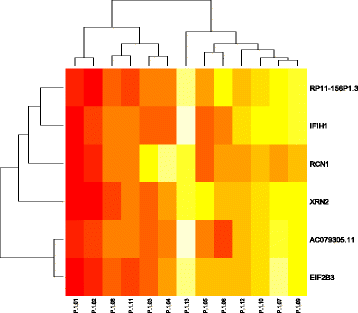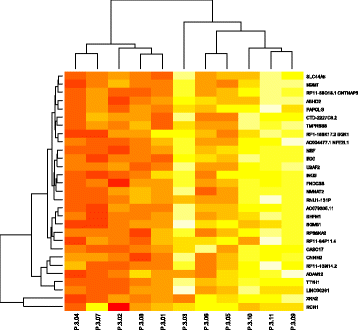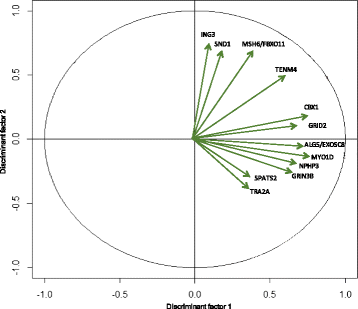Global analysis of H3K27me3 as an epigenetic marker in prostate cancer progression
- PMID: 28403887
- PMCID: PMC5388998
- DOI: 10.1186/s12885-017-3256-y
Global analysis of H3K27me3 as an epigenetic marker in prostate cancer progression
Abstract
Background: H3K27me3 histone marks shape the inhibition of gene transcription. In prostate cancer, the deregulation of H3K27me3 marks might play a role in prostate tumor progression.
Methods: We investigated genome-wide H3K27me3 histone methylation profile using chromatin immunoprecipitation (ChIP) and 2X400K promoter microarrays to identify differentially-enriched regions in biopsy samples from prostate cancer patients. H3K27me3 marks were assessed in 34 prostate tumors: 11 with Gleason score > 7 (GS > 7), 10 with Gleason score ≤ 7 (GS ≤ 7), and 13 morphologically normal prostate samples.
Results: Here, H3K27me3 profiling identified an average of 386 enriched-genes on promoter regions in healthy control group versus 545 genes in GS ≤ 7 and 748 genes in GS > 7 group. We then ran a factorial discriminant analysis (FDA) and compared the enriched genes in prostate-tumor biopsies and normal biopsies using ANOVA to identify significantly differentially-enriched genes. The analysis identified ALG5, EXOSC8, CBX1, GRID2, GRIN3B, ING3, MYO1D, NPHP3-AS1, MSH6, FBXO11, SND1, SPATS2, TENM4 and TRA2A genes. These genes are possibly associated with prostate cancer. Notably, the H3K27me3 histone mark emerged as a novel regulatory mechanism in poor-prognosis prostate cancer.
Conclusions: Our findings point to epigenetic mark H3K27me3 as an important event in prostate carcinogenesis and progression. The results reported here provide new molecular insights into the pathogenesis of prostate cancer.
Keywords: Cancer; ChIP-on-chip; Epigenetics; H3K27me3; Histone methylation; Prostate.
Figures





Similar articles
-
The association between histone 3 lysine 27 trimethylation (H3K27me3) and prostate cancer: relationship with clinicopathological parameters.BMC Cancer. 2014 Dec 23;14:994. doi: 10.1186/1471-2407-14-994. BMC Cancer. 2014. PMID: 25535400 Free PMC article.
-
Genome-wide profiling of histone h3 lysine 4 and lysine 27 trimethylation reveals an epigenetic signature in prostate carcinogenesis.PLoS One. 2009;4(3):e4687. doi: 10.1371/journal.pone.0004687. Epub 2009 Mar 5. PLoS One. 2009. PMID: 19262738 Free PMC article.
-
Altered DNA methylation landscapes of polycomb-repressed loci are associated with prostate cancer progression and ERG oncogene expression in prostate cancer.Clin Cancer Res. 2013 Jul 1;19(13):3450-61. doi: 10.1158/1078-0432.CCR-12-3139. Epub 2013 Apr 2. Clin Cancer Res. 2013. PMID: 23549870
-
Epigenetic biomarkers in prostate cancer: Current and future uses.Cancer Lett. 2014 Jan 28;342(2):248-56. doi: 10.1016/j.canlet.2012.02.011. Epub 2012 Mar 3. Cancer Lett. 2014. PMID: 22391123 Review.
-
Epigenetic modifications in prostate cancer.Epigenomics. 2014;6(4):415-26. doi: 10.2217/epi.14.34. Epigenomics. 2014. PMID: 25333850 Review.
Cited by
-
Epigenetic mechanisms underlying prostate cancer radioresistance.Clin Epigenetics. 2021 Jun 8;13(1):125. doi: 10.1186/s13148-021-01111-8. Clin Epigenetics. 2021. PMID: 34103085 Free PMC article. Review.
-
High expression of spermatogenesis associated serine rich 2 promotes tumorigenicity in esophageal squamous cell carcinoma cells and is associated with poor patient prognosis.Exp Ther Med. 2021 Jul;22(1):698. doi: 10.3892/etm.2021.10130. Epub 2021 May 2. Exp Ther Med. 2021. PMID: 33986862 Free PMC article.
-
Comprehensive evaluation of SPATS2 expression and its prognostic potential in liver cancer.Medicine (Baltimore). 2020 Feb;99(9):e19230. doi: 10.1097/MD.0000000000019230. Medicine (Baltimore). 2020. PMID: 32118724 Free PMC article.
-
Contemporary Update on Clinical and Experimental Prostate Cancer Biomarkers: A Multi-Omics-Focused Approach to Detection and Risk Stratification.Biology (Basel). 2024 Sep 25;13(10):762. doi: 10.3390/biology13100762. Biology (Basel). 2024. PMID: 39452071 Free PMC article. Review.
-
H3K27me3 in Diffuse Midline Glioma and Epithelial Ovarian Cancer: Opposing Epigenetic Changes Leading to the Same Poor Outcomes.Cells. 2022 Oct 26;11(21):3376. doi: 10.3390/cells11213376. Cells. 2022. PMID: 36359771 Free PMC article. Review.
References
MeSH terms
Substances
LinkOut - more resources
Full Text Sources
Other Literature Sources
Medical
Miscellaneous

